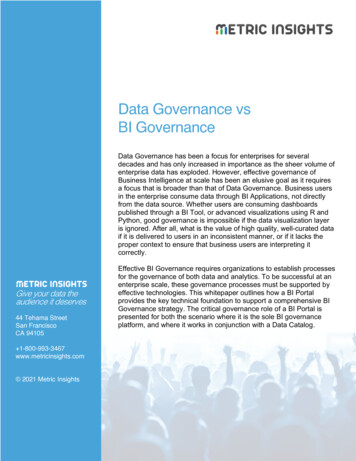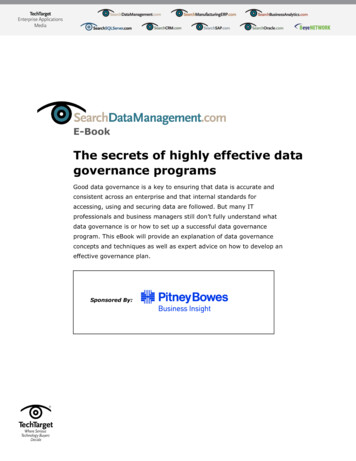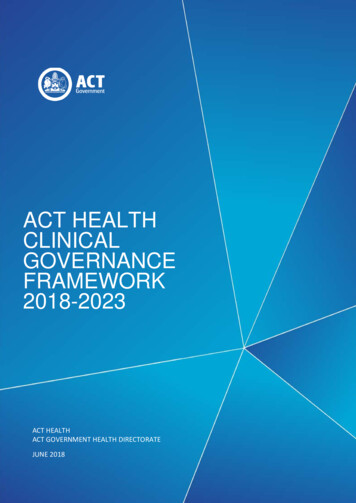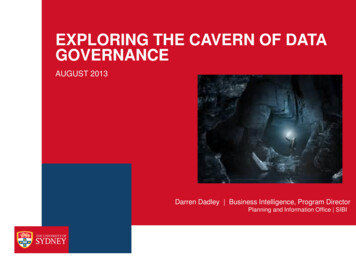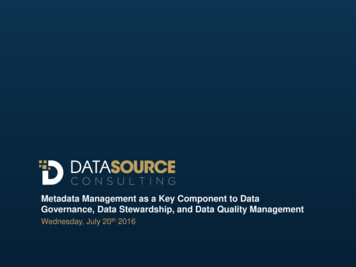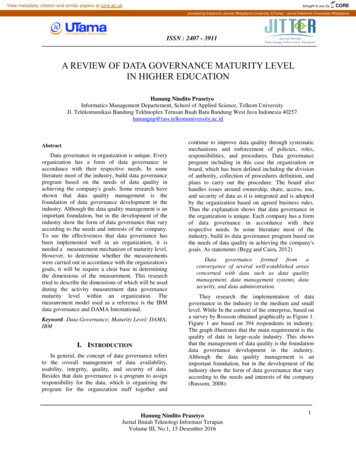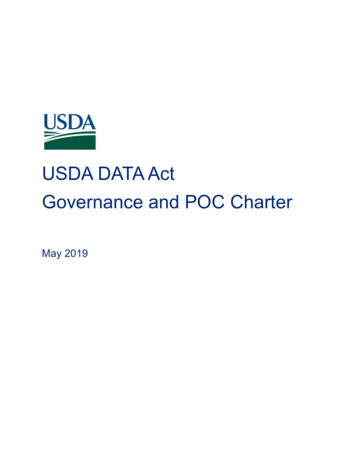
Transcription
USDA DATA ActGovernance and POC CharterMay 2019
Table of Contents1. Objective . 22. Vision. 23. USDA DATA Act Governance . 23.1 USDA DATA Act Governance Structure . 23.2 Organizational Structure of the USDA OCFO . 33.3 Roles and Responsibilities . 44. Governance Process. 54.1 Bulletins, Publications, Memoranda, and Data Schema . 54.2 USDA DATA Act Files and Timeline for Data Submission . 64.3 DATA Act Reporting Challenges . 75. Relationships within Governance Structure . 75.1 Framework of Interaction . 75.2 Meetings . 76. Oversight Process . 86.1 Management Oversight . 86.2 Governance Changes. 87. Appendix A – POC Charter . 97.1 Overview . 97.2 USDA DATA Act Issues and Concerns . 97.3 Preferred Method of Contact . 9DATA Act Governance Document/POC CharterMay 20191
1. ObjectiveTo improve the quality of data, the DATA Act requires that agency-reported award and financialinformation comply with new data standards established by The Office of Management and Budget(OMB) and the U.S. Department of Treasury (Treasury). These standards specify the items to bereported under the DATA Act and define and describe what is to be included in each element with theaim of ensuring that the information is consistent and comparable.This document describes the current governance processes and structure, outlines the vision, providesan overview of the organizational structure and communication protocols, and describes the process forissue resolution used by the USDA to facilitate DATA Act implementation.2. VisionThe USDA Office of the Chief Financial Officer (OCFO) leads the department-wide implementation of theDATA Act and sets forth strategies to facilitate any changes necessary to implement timely DATA Actreporting. The OCFO strives to create an environment in which USDA officials have and use high qualityfinancial and performance information to make effective policy, management, and program decisions thatcomply with DATA Act reporting requirements.3. USDA DATA Act GovernanceThe framework used at the U.S. Department of Agriculture (USDA) for making and implementingdecisions to facilitate compliance with the laws and regulations of the DATA Act is described below. It isdesigned to help make an effective and efficient transition. The key objectives are to help incomingpersonnel understand the key oversight activities and to develop a plan to address challenges.3.1 USDA DATA Act Governance StructureThrough continuous assessment, the USDA DATA Act Governance determines what areas require themost attention as well as the skills, knowledge, processes, and information that provide the bestopportunity for improvement. The USDA entities responsible for setting the policies and procedures usedto meet the requirements of DATA Act reporting are the: USDA Chief Financial Officer (CFO) – USDA has designated its CFO as the Senior AccountableOfficial (SAO) for DATA Act implementation. The USDA SAO is responsible for the implementationand compliance with the DATA Act, which includes closely overseeing the governance and progress.Associate CFO (ACFO) for Financial Operations – Provides direction to USDA agencies for financialreporting through the Accounting Policy and Consolidated Reporting Division (APCRD) and theTransparency and Accountability Reporting Division (TARD).o Financial Management Services (FMS) – FMS offers an SAP-based core financial system,financial transactional processing services, and a grants management solution. FMScurrently serves 29 agencies and staff offices.o The Director of the USDA Transparency and Accountability Reporting Division (TARD) –TARD is responsible for timely DATA Act reporting as well as developing, coordinating, andaddressing Federal financial assistance policy.ACFO for Shared Services - Responsible for the preparation of USDA’s consolidated financialstatements, external financial reports, and DATA Act compliance reporting.o Federal Shared Service Provider (FSSP) – USDA is certified by the U.S. Department ofTreasury (Treasury) as an FSSP.o Pegasys Financial Services (PFS) – PFS offers a Momentum-based core financial systemand financial transactional processing services. PFS currently provides financial services toDATA Act Governance Document/POC CharterMay 20192
the U.S General Services Administration (GSA) and 39 other external clients comprised ofBoards, Commissions, and Small Agencies. USDA Component Agency Primary Points of Contact (POCs) are responsible for coordinatingcommunications with their agency’s Subject Matter Experts (SMEs) on financial accounting, budget,systems, financial assistance, and procurement matters.o SMEs - Includes members from across USDA, such as budget, accounting, grants,procurement, loans, other financial assistance and information technology with experience indesigning and creating the infrastructure of USDA business and Information Technology (IT)solutions used for federal spending.3.2 Organizational Structure of the USDA OCFOThe USDA Office of the Chief Financial Officer (OCFO) is responsible for the financial leadership of anenterprise that has 96,000 employees, 4,500 offices and field locations1, 239 billion in assets2, and 145billion in annual spending3. The CFO serves as the principal advisor to the USDA Secretary and SeniorOfficials on all matters related to financial management, financial management systems, financial controland accounting, internal control and assessment and financial management training. The following chartdepicts the organizational structure of the USDA OCFO:1https://www.usda.gov/our-agencyFY 2018 AFR, Balance Sheet3 USDA FY 2019 APP, p. 802DATA Act Governance Document/POC CharterMay 20193
3.3 Roles and ResponsibilitiesThe USDA Governance components understand and monitor USDA’s strategic, operational, financial,and compliance requirements, establishing an alignment with strategic priorities. The areas ofresponsibility for each governance component are as follows. The USDA OCFO is responsible for:o Financial system management policy and providing timely, accurate, and reliable informationfrom financial systems;o Developing financial statements, cost accounting policy, and financial management budgets;o Policy guidance and oversight of the Department's internal controls and managementaccountability programs and reporting to ensure adequate controls over Department assets;o Oversight of the Departmental Working Capital Fund (WCF); ando Providing policy guidance and oversight of the travel system, grants management, cash andcredit management operations, and other financial management functions. The office of the ACFO for Financial Operations provides direction to USDA agencies for financialreporting through the Accounting Policy and Consolidated Reporting Division (APCRD) and theTransparency and Accountability Reporting Division (TARD).o APCRD is responsible for: Developing departmental accounting policies and procedures to comply with FederalAccounting Standards Advisory Board (FASAB) standards and government-widereporting requirements. Coordinating preparation and audit of the annual USDA consolidated financialstatements and data for the government-wide financial report. Representing the department on matters related to these assignments with internaland external organizations. Conducting biennial review of charges for things of value.o TARD is responsible for: Developing, coordinating, and addressing Federal financial assistance policy. DATA Act reporting, which provides the public with Federal financial assistance andcontracts data. Supporting Prize and Competition policy, Federal Travel reporting, publication of theAnnual Financial Report, other new financial assistance, and other financial reportinginitiatives as they arise. Assuring senior level officials at USDA and within USDA agencies are aware of anynew implementation processes and requirements in terms of financial assistancepolicy. Notifying stakeholders of these new implementation processes and requirements viaan official memorandum, signed by the CFO.The office of the ACFO for Financial Policy and Planning is responsible for:o Establishing and approving component agency programs, policies, standards, systems,techniques and procedures to improve the management and operational efficiency andeffectiveness.o Developing, and coordinating policy concerning audit, debt, cash, improper payments, andtravel management.o Providing budget, accounting, fiscal, and related financial management services.o Establishing policies related to the Working Capital Fund.o Developing financial management budgets.o Establishing policies, standards, techniques, and procedures applicable to all USDAagencies. The office of the AFCO for Shared Services – is responsible for:o Providing executive leadership and management vision to direct and implement corporatefinancial information and other delegated systems.o Ensuring compliance with external mandates and enhance financial informationdissemination and financial accountability.DATA Act Governance Document/POC CharterMay 20194
oo Implementing a comprehensive data warehouse reporting tool which provides real timeaccess to key financial data.Implementing corporate administrative systems strategy.FMS has responsibility for USDA's financial management and reporting, administrative paymentsprocessing and certification, agency customer support, financial training administration, and relatedregulatory and Departmental accounting and policy compliance.The Office of the Inspector General (OIG) conducts audit reviews of OCFO programs andprocedures.Customer Account Manager (CAM) serves as a liaison between FMS and TARD to keep both partiesapprised the status of fixes, system updates and other matters related to DATA Act reporting thatFMS manages.USDA Component Agency Primary POCs are responsible for coordinating communications withSMEs on financial accounting, budget, systems, financial assistance, and procurement matters. ThePOCs also perform oversight of the component agency’s reporting compliance and datareconciliation.4. Governance ProcessA core requirement of the DATA Act is the development of government-wide data standards to ensure thereporting of reliable, consistent federal spending data for public use and the reporting of data incompliance with the standards. The policies, procedures, and communication used by the USDA tocomply with the Treasury requirements for DATA Act reporting are described below:4.1 Bulletins, Publications, Memoranda, and Data SchemaCommunication and the open exchange of ideas between federal and non-federal stakeholders onimplementation of the DATA Act will improve the quality of federal spending data under the FederalFunding Accountability and Transparency Act (FFATA).The following is a list of links to bulletins and publications related to the implementation of the DATA Actand the reporting of data in compliance with the open standards created under the DATA Act: From August 2016, this GAO report provides an update and initial observations on the status of theefforts by Treasury and OMB regarding DATA Act implementation. DATA Act: Initial Observations onTechnical Implementation Dated February 2017, this document describes the processes, systems, and controls that USDA hasimplemented, and plans to implement, to report financial and payment data in accordance with theDATA Act requirements. USDA Implementation of the Digital Accountability and Transparency Act of2014 (DATA Act) – Readiness Review – Interim Report This GAO audit, dated April 2017, focuses on what is already known about existing DATA Actchallenges that affect the quality of agency financial data as well as issues that will affect data qualityas agencies begin to report data. DATA Act: As Reporting Deadline Nears, Challenges Remain ThatWill Affect Data Quality. OMB and Treasury developed phased guidance for implementation of the DATA Act. Guidancewhich to date includes OMB Memorandum 15-12, Management Procedures Memorandum (MPM)2016-03 and OMB Memorandum 17-04. Treasury provides DATA Act requirements and instructions within the DATA Act Information ModelSchema (DAIMS). Each release is comprised of several documents which include Practices andProcedures, validation rules, and data field specific schema.The following documents and reporting schedules are provided for public viewing at Treasury’s DataTransparency web site. The most recent documents are presented on the DAIMS page of the site.o DAIMS v1.0 was released in April 2016 and implemented in April 2017.DATA Act Governance Document/POC CharterMay 20195
ooooDAIMS v1.1 was released in June 2017 and implemented in September. This versionprovided clarifications and instituted the move of File D2 reporting to the Treasury Broker.DAIMS v1.2 was released in December 2017 and implemented May 2018. This releaseestablished reporting methods for the protection of Personally Identifiable Information (PII) onawards to private individuals per OMB-17-04.DAIMS v1.3 was released in June 2018 with multiple implementation dates ranging fromOctober 2018 to July 2019, including the OMB requirement to identify agency offices whichfund and award financial assistance.DAIMS v1.3.1 was released February 2019. This was a system maintenance release withlow impact on agency reporting processes. Details can be found in the Release Notes.4.2 USDA DATA Act Files and Timeline for Data SubmissionThe USDA generates and submits Files A, B, and C on a quarterly basis to Treasury’s DATA Act BrokerSubmission (DABS). Data specific to financial assistance awards are generated and submitted in File D2on a twice-monthly basis to Treasury’s Financial Assistance Broker Submission (FABS). USDA employsinternal data validation and error correction processes and provides a quarterly assurance of data qualityto Treasury. As part of DATA Act compliance requirements, the USDA submits the following financial andaward data files: File A - Appropriation Account Detail File B - Object Class Program Activity Detail File C - Award-level Financial Detail File D2 - Financial Assistance Award Detail4.2.1 Schedule for DATA Act File A, B, and C SubmissionThe USDA has defined the tasks and timeline required for successful submission of File A, B and C foreach quarter. FSSP clients and USDA component agency SAOs provide a signed quarterly assurancestatement to TARD each quarter. A brief description of each task, responsible agencies, and thetimeframe for each task are described in the table below:Task ItemStartthFinishthBegin Repository Processingof Files A, B, and C19 day of Jan., April, July, Oct.20 day of Jan., April, July, Oct.Certification/Error ReportsDistributed to Agency SharedMailboxError File Correction Periodfor AgenciesRepository Reprocessing ofError CorrectionsCertification/Error ReportsDistributed to Agency SharedMailbox, as applicableComponent CFO Review andSigned AssuranceData Submitted to TreasuryDATA Act Broker20th day of Jan., April, July, Oct.20th day of Jan., April, July, Oct.20th day of Jan., April, July, Oct.28th day of Jan., April, July, Oct.28th day of Jan., April, July, Oct.28th day of Jan., April, July, Oct.28th day of Jan., April, July, Oct.28th day of Jan., April, July, Oct.28th day of Jan., April, July, Oct.8th day of Feb., May, Aug., Nov.8th day of Feb., May, Aug., Nov.15th day of Feb., May, Aug., Nov.DATA Act Governance Document/POC CharterMay 20196
4.2.2 Schedule for DATA Act D2 File SubmissionThe DATA Act D2 File submission process runs on a twice-monthly basis. Agencies must send a copy ofthe submitted file along with a signed certification letter to both the agency’s shared mailbox and the D2Certification mailbox (sm.ocfo.d2cert@ usda.gov) within 24 hours for documentation and possible dataanalysis needs. File acceptance and validation notifications are provided to agency shared mailboxeswithin 24 hours. Agency resubmissions with corrected records will be processed on the date of the nextprocessing window. Agencies will be notified if further action is needed on data failing validation at FABS.Overview of the DATA ACT D2 File submission process: First twice-monthly processingo 2nd of the month – CRM Extract is run and agencies submit files manually to drop boxo 3rd of the month – D2 Internal Process runs at 6:30 AM CTo 5th of the month – Files are submitted to the FABS portalSecond twice-monthly processingo 17th of the month - CRM Extract is run and agencies submit files manually to drop boxo 18th of the month – D2 Internal Process runs at 6:30 AM CTo 20th of the month – Files are submitted to the FABS portal4.3 DATA Act Reporting ChallengesoAfter an assessment of the DATA Act reporting process was performed, it was discoveredthat in addition to the ongoing process of resolving issues and enhancing the back-endsolution, other areas of the DATA Act reporting process could be improved. The followingimprovements have been proposed: Leverage Treasury’s API access for submission of USDA data. Automate internal handling of component agency files. Provide a central platform on the FMMI Web Portal for component agency file submission, includingreal-time receipt confirmation and validation status updates.5. Relationships within Governance StructureSuccessful implementation of the DATA Act is of the utmost importance to both Federal and non-Federalstakeholders. To help ensure successful implementation of the DATA Act, communication and feedbackfrom stakeholders inside and outside the Federal government is necessary. A system of two-waycommunication and the open exchange of ideas between Federal and non-Federal stakeholders hasbeen set up to resolve issues, report status, and communicate changes related to the DATA Act.5.1 Framework of InteractionWhen USDA identifies challenges that could impede its progress towards implementing the DATA Act, itdrafts solutions to meet the challenges. As part of the solution, TARD consults with OMB to interpretTreasury policy mandates. Data calls will take place, upon the request of OMB or as needed, for internalassessment among SMEs and user groups.5.2 MeetingsRegularly scheduled meetings have been set up to facilitate DATA Act policy discussion, issue resolution,requirements updates, and to answer questions. The USDA OCFO participates in the following meetingsrelated to DATA Act: USDA Quarterly DATA Act POC meeting with component agencies to discuss DATA Act updates andanswer questionsDATA Act Governance Document/POC CharterMay 20197
TARD bi-weekly meeting with Financial Management Services (FMS) project leaders to discussDATA Act status and issuesOMB and Treasury meetings include:o Monthly DATA Act Office Hours conference call with OMB and Treasury.o Tech Thursday in-person working sessions with Treasury’s DATA Act Program ManagementOffice (PMO).OCFO monthly meeting with the CFO Council to discuss DATA Act status and issues with CFOs OCFO meets with component agencies and Ad Hoc Groups on an as-needed basis 6. Oversight ProcessThe USDA governance entities provide oversight of system and component agency activity to ensurecompliance with the Treasury requirements for DATA Act reporting. Through the oversight process, theUSDA ensures timely, complete, and accurate data is provided to the American public. .6.1 Management OversightThe USDA DATA ACT Governance structure allows multi-level monitoring of systems and agencyparticipation. The oversight includes confirmation that an adequate system of internal controls isestablished and maintained to identify and mitigate problems that may impact the timeliness and accuracyof reported data. . Compliance Monitoring – Component agency activity and data are monitored for compliance andquality to ensure that the data displayed on public websites is complete and accurate. System Assurances – Changes to financial and grants management systems mandated by updatedTreasury guidance are initiated and monitored through the ServiceNow system. Compliance Challenges – OCFO works directly with component agencies to identify and addressreporting and data quality challenges. Continuous improvements for automation, additional reports, and enhancements are used to ensureaccurate, complete, and timely data reporting.6.2 Governance ChangesFrom time to time the Treasury may make programmatic changes to the DATA Act standards to ensurebetter, more useful data from agencies. Treasury mandates are monitored at the federal level to ensureUSDA is aware of new requirements or documentation.DATA Act Governance Document/POC CharterMay 20198
7. Appendix A – POC Charter7.1 OverviewThe DATA Act requires the component agencies to report award and financial information that complieswith the data standards established by OMB and Treasury. These standards specify the items to bereported under the DATA Act and define and describe what is to be included in each element with theaim of ensuring that the information is consistent and comparable.The USDA OCFO leads the department-wide implementation of the DATA Act and set forth strategiesto facilitate any changes necessary to implement timely DATA Act reporting. As part of the strategy,the TARD is responsible for DATA Act reporting and resolving any issues and concerns related to theDATA Act.7.2 USDA DATA Act Issues and ConcernsDATA Act reporting requires collection of data, generation of datasets, assurance of data quality, anddata submission. Occasionally, issues and concerns may arise during the DATA Act reporting process.Typically, the issues experienced by DATA Act users fall into five categories, the categories are: DATA Act Policy Issues DATA Act Data Element Issues DATA Act Reporting Errors USAspending.gov Website Issues Other DATA Act Issues7.3 Preferred Method of ContactFor all USDA DATA Act issues and concerns, the preferred method of contact is to contact a TARD teammember directly via email. The TARD team will then provide a resolution directly or escalate the issue asfollows: DATA Act Policy Issues - For any issues related to DATA Act Policy, the first step is to contact theTARD team. If the TARD team is unable to resolve the policy issue, it will be escalated to OMBOffice of Federal Financial Management for resolution.DATA Act Data Element Issues - The first step is to report any DATA Act Data Element Issues to theTARD team. If escalation is required, the TARD team will contact U.S. Department of Treasury DATAAct Broker Help Desk for a resolution.DATA Act Reporting Errors - DATA Act Reporting Errors should first be reported to the TARD team.If necessary, the TARD team will escalate the issue to FMS via a ServiceNow ticket for resolution.USAspending.gov Website Issues – Issues with the USAspending.gov website should be reported tothe TARD team. If the TARD team is unable to resolve the issue, the issue will be escalated to theUSAspending.gov Helpdesk.All other DATA Act issues, including conflict resolution and decision-making, should be reported tothe TARD team. TARD will work with OMB, Treasury, or FMS to address issues.DATA Act Governance Document/POC CharterMay 20199
DATA Act Governance Document/POC Charter 4 May 2019 3.3 Roles and Responsibilities The USDA Governance components understand and monitor USDA's strategic, operational, financial, and compliance requirements, establishing an alignment with strategic priorities. The areas of responsibility for each governance component are as follows.


